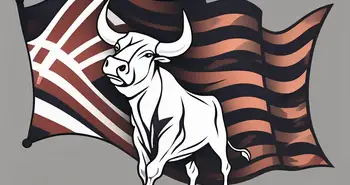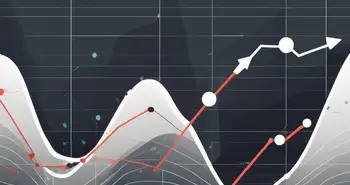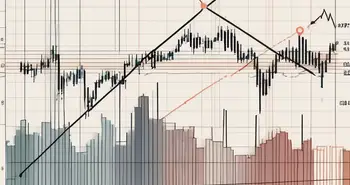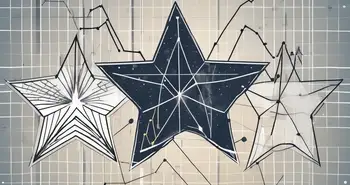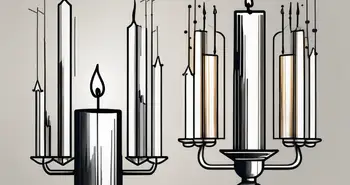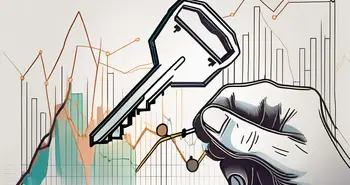A Guide for the Downward Flag Pattern
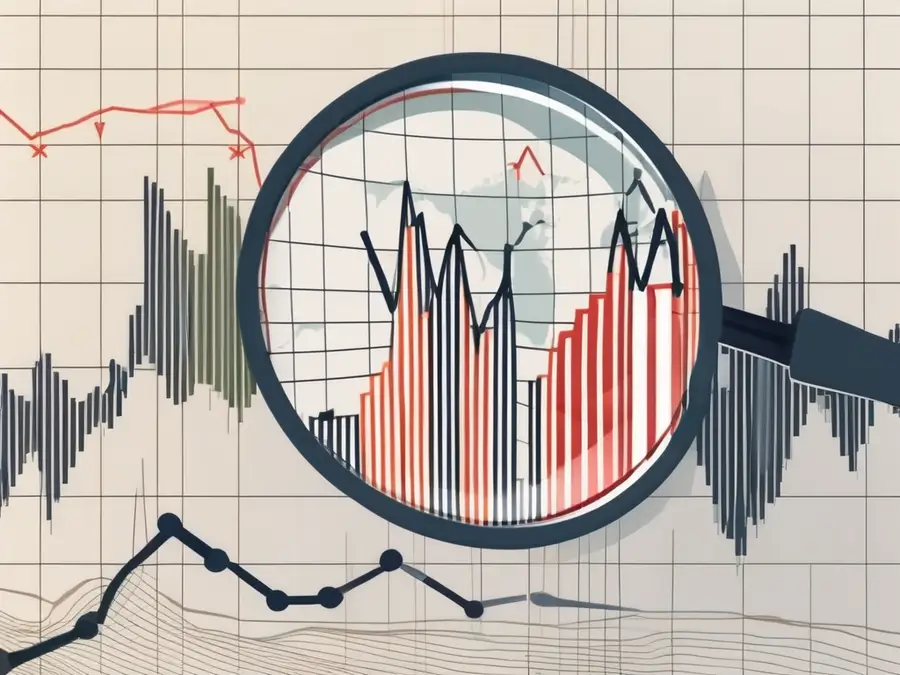
As a seasoned trader, I've come across various patterns and trends that can help identify profitable opportunities in the market. One pattern that I've found particularly intriguing is the downward flag pattern. In this guide, I'll take you through the basics of this pattern, explain its importance in trading, and provide strategies for trading it effectively. So, let's dive in and uncover the secrets of the downward flag pattern!
Understanding the Basics of Downward Flag Pattern
Before we delve deeper, let's define what the downward flag pattern actually is. Essentially, it is a continuation pattern that occurs within a downtrend. It is characterized by a period of consolidation, where the price retraces slightly against the prevailing downtrend, forming a flag-like shape. This is followed by a continuation of the downtrend, often with a sharp decline in price.
Definition of Downward Flag Pattern
The downward flag pattern consists of two key components: the flagpole and the flag. The flagpole is the initial downtrend that precedes the pattern, while the flag is the period of consolidation. The flag is formed by parallel trendlines, with the upper trendline representing resistance and the lower trendline acting as support.
Importance of Downward Flag Pattern in Trading
The downward flag pattern is important for traders as it provides valuable information about market sentiment and potential price movements. By identifying this pattern, traders can anticipate the continuation of the downtrend and take advantage of potential profit opportunities.
Identifying the Downward Flag Pattern in the Market
Identifying the downward flag pattern requires a careful analysis of price charts and understanding its key characteristics.
Key Characteristics of the Downward Flag Pattern
When analyzing charts for the downward flag pattern, keep an eye out for the following characteristics:
- The flag is typically tilted in the direction opposite to the trend.
- The flagpole is marked by a significant decline in price, often with high trading volume.
- The flag should not last for an extended period and should be relatively short-lived compared to the flagpole.
- During the consolidation phase, the trading volume usually tapers off.
- Breakout occurs when the price breaks below the lower trendline, confirming the resumption of the downtrend.
Common Mistakes in Identifying the Pattern
While identifying the downward flag pattern, traders may encounter a few common pitfalls. One mistake is misinterpreting a retracement as a reversal, leading to missed opportunities. It's crucial to remember that the downward flag pattern is a continuation pattern within a larger downtrend.
The Role of Volume in the Downward Flag Pattern
Volume plays a significant role in confirming the validity of the downward flag pattern and providing insights into the potential strength of the upcoming downtrend.
How Volume Influences the Pattern
During the consolidation phase of the downward flag pattern, the trading volume tends to decrease. This decline in volume suggests a temporary equilibrium between buyers and sellers. However, when the breakout occurs and the downtrend resumes, an increase in volume confirms the continuation of the selling pressure.
Interpreting Volume Changes
As a trader, it's important to closely monitor volume changes during the downward flag pattern. Substantial increases in volume during the breakout indicate a higher probability of a sustained downtrend. Conversely, low volume during the breakout may suggest weak selling pressure, requiring caution in entering or exiting trades.
Strategies for Trading the Downward Flag Pattern
Successfully trading the downward flag pattern requires a well-thought-out strategy. Let's explore some key strategies for effectively trading this pattern in the market.
Timing Your Entry and Exit
Timing is crucial when trading the downward flag pattern. It's often wise to enter a short position as the price breaks below the lower trendline, confirming the downtrend continuation. Setting stop-loss orders above the upper trendline can help manage risk, while taking profits can be done when the price reaches a predetermined target or shows signs of a potential reversal.
Risk Management Strategies
Risk management should always be a priority in trading. Utilize proper position sizing and consider employing trailing stop-loss orders to protect profits as the downtrend extends. Additionally, regular analysis and adjustment of stop-loss levels based on price action can help protect against unexpected market moves.
The Downward Flag Pattern vs Other Trading Patterns
While the downward flag pattern is undoubtedly a powerful tool for traders, it's essential to understand its similarities and differences compared to other trading patterns.
Similarities and Differences
The downward flag pattern shares some similarities with other continuation patterns, such as the pennant and the symmetrical triangle. However, it differs in terms of its shape and duration of consolidation. Understanding these nuances can help traders make more informed decisions when choosing the most suitable pattern for their trading style.
Choosing the Right Pattern for Your Trading Style
Ultimately, the choice of pattern depends on your trading style, risk tolerance, and the market conditions you're dealing with. Experiment with different patterns and find the one that aligns best with your trading strategy and objectives.
Throughout my trading career, I've encountered many traders who overlook the power of the downward flag pattern. Yet, time and again, I've seen its effectiveness in predicting future price movements. By incorporating this pattern into your trading analysis, you can unlock hidden opportunities and enhance your overall trading performance.
FAQ
What is the downward flag pattern?
The downward flag pattern is a continuation pattern that occurs within a downtrend. It is formed by a period of consolidation, resembling a flag, followed by a continuation of the downtrend with a sharp decline in price.
How do I identify the downward flag pattern?
Identifying the downward flag pattern involves analyzing price charts. Look for the flag, which is a period of consolidation with parallel trendlines acting as resistance and support. Additionally, watch for the flagpole, which is the initial downtrend that precedes the pattern.
What role does volume play in the downward flag pattern?
Volume is essential in confirming the validity of the downward flag pattern. A decrease in volume during the consolidation phase suggests a temporary equilibrium, while an increase in volume during the breakout confirms the continuation of the downtrend.
What strategies can I use to trade the downward flag pattern?
To effectively trade the downward flag pattern, timing your entry and exit is crucial. Consider entering a short position as the price breaks below the lower trendline, setting stop-loss orders above the upper trendline, and taking profits at predetermined targets. Implementing proper risk management strategies is also important.
How does the downward flag pattern compare to other trading patterns?
The downward flag pattern shares similarities with other continuation patterns, such as the pennant and the symmetrical triangle. However, it differs in terms of its specific shape and duration of consolidation. Understanding these differences can help you choose the most suitable pattern for your trading style.
In conclusion, the downward flag pattern is an invaluable tool in a trader's arsenal. By mastering its identification and implementing sound trading strategies, you can capitalize on its potential and increase your trading success. So, harness the power of the downward flag pattern and unlock a world of new trading opportunities!
Ready to put the downward flag pattern into action? Join Morpher today and experience a trading platform that's as innovative as your strategies. With zero fees, infinite liquidity, and the ability to trade a vast array of assets from cryptocurrencies to collectibles, Morpher is designed to elevate your trading game. Embrace the power of blockchain technology for a safer, more controlled investing experience with fractional investing, short selling, and up to 10x leverage. Don't miss out on this transformative trading journey. Sign Up and Get Your Free Sign Up Bonus now, and start trading the way you've always wanted to!

Disclaimer: All investments involve risk, and the past performance of a security, industry, sector, market, financial product, trading strategy, or individual’s trading does not guarantee future results or returns. Investors are fully responsible for any investment decisions they make. Such decisions should be based solely on an evaluation of their financial circumstances, investment objectives, risk tolerance, and liquidity needs. This post does not constitute investment advice.

Painless trading for everyone
Hundreds of markets all in one place - Apple, Bitcoin, Gold, Watches, NFTs, Sneakers and so much more.

Painless trading for everyone
Hundreds of markets all in one place - Apple, Bitcoin, Gold, Watches, NFTs, Sneakers and so much more.

